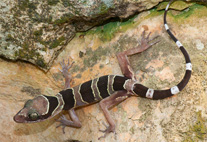Abstract
An integrative taxonomic analysis of three newly discovered populations of the gekkonid genus Cyrtodactylus Gray from Merapoh, Pahang; Gunung Stong, Kelantan; and Gunung Tebu, Terengganu indicate they are part of the C. pulchellus complex and each is a new species and thusly named Cyrtodactylus sharkari sp. nov., C. jelawangensis sp. nov., and C. timur sp. nov., respectively. Each species bears a unique suite of morphological and color pattern characters separating them from each other and all other nominal species in the C. pulchellus complex. Their phylogenetic relationships to each other and other species in the C. pulchellus complex were unexpected in that they are not in accordance with the general distribution of the species in this complex, underscoring the intricate historical biogeography of the Thai-Malay Peninsula. These descriptions highlight our current lack of knowledge concerning the herpetological diversity and distribution of species in northeastern Peninsular Malaysia.

